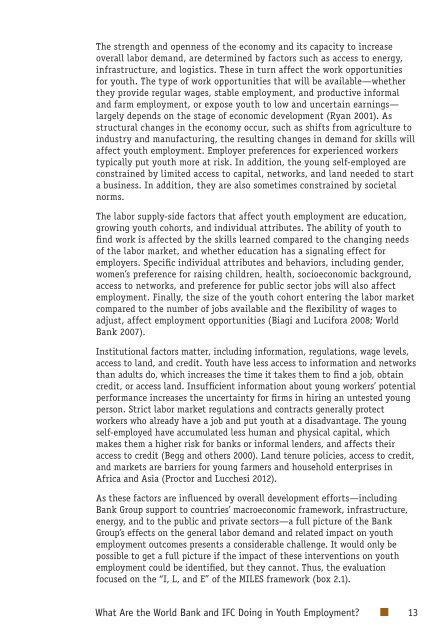Youth Employment Programs - Independent Evaluation Group
Youth Employment Programs - Independent Evaluation Group
Youth Employment Programs - Independent Evaluation Group
Create successful ePaper yourself
Turn your PDF publications into a flip-book with our unique Google optimized e-Paper software.
The strength and openness of the economy and its capacity to increaseoverall labor demand, are determined by factors such as access to energy,infrastructure, and logistics. These in turn affect the work opportunitiesfor youth. The type of work opportunities that will be available—whetherthey provide regular wages, stable employment, and productive informaland farm employment, or expose youth to low and uncertain earnings—largely depends on the stage of economic development (Ryan 2001). Asstructural changes in the economy occur, such as shifts from agriculture toindustry and manufacturing, the resulting changes in demand for skills willaffect youth employment. Employer preferences for experienced workerstypically put youth more at risk. In addition, the young self-employed areconstrained by limited access to capital, networks, and land needed to starta business. In addition, they are also sometimes constrained by societalnorms.The labor supply-side factors that affect youth employment are education,growing youth cohorts, and individual attributes. The ability of youth tofind work is affected by the skills learned compared to the changing needsof the labor market, and whether education has a signaling effect foremployers. Specific individual attributes and behaviors, including gender,women’s preference for raising children, health, socioeconomic background,access to networks, and preference for public sector jobs will also affectemployment. Finally, the size of the youth cohort entering the labor marketcompared to the number of jobs available and the flexibility of wages toadjust, affect employment opportunities (Biagi and Lucifora 2008; WorldBank 2007).Institutional factors matter, including information, regulations, wage levels,access to land, and credit. <strong>Youth</strong> have less access to information and networksthan adults do, which increases the time it takes them to find a job, obtaincredit, or access land. Insufficient information about young workers’ potentialperformance increases the uncertainty for firms in hiring an untested youngperson. Strict labor market regulations and contracts generally protectworkers who already have a job and put youth at a disadvantage. The youngself-employed have accumulated less human and physical capital, whichmakes them a higher risk for banks or informal lenders, and affects theiraccess to credit (Begg and others 2000). Land tenure policies, access to credit,and markets are barriers for young farmers and household enterprises inAfrica and Asia (Proctor and Lucchesi 2012).As these factors are influenced by overall development efforts—includingBank <strong>Group</strong> support to countries’ macroeconomic framework, infrastructure,energy, and to the public and private sectors—a full picture of the Bank<strong>Group</strong>’s effects on the general labor demand and related impact on youthemployment outcomes presents a considerable challenge. It would only bepossible to get a full picture if the impact of these interventions on youthemployment could be identified, but they cannot. Thus, the evaluationfocused on the “I, L, and E” of the MILES framework (box 2.1).What Are the World Bank and IFC Doing in <strong>Youth</strong> <strong>Employment</strong>? 13
















